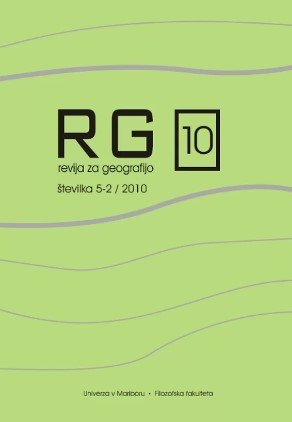Structural Changes in Agriculture in the Pomurje Region After 1991
Abstract
The Pomurje region is the most agricultural and the least developed region in Slovenia. Since 1991, the year when Slovenia gained its independence, the country transformed from the socialist system to the free market capitalism and was forced to restructure the agricultural policy. The decrease and the aging of the population, the abandon of the agriculture production and the decay of cultural landscape turned out to be serious problems. In Pomurje, agriculture was faced with unfavourable age structure of farmers in family farms. The Slovene agricultural policy was aware of this problem and took a number of measures to encourage the aging farmers to retire and the young generation to take over. Alongside this process began the process of merging land in the Pomurje rural areas. In the last 10 years, the agriculture in Pomurje underwent the improvement of agricultural technology, the specialization of productions and the enlargement of farms.
Downloads
References
Boden, M. 2004: Evropa naša preteklost in sedanjost. Ljubljana: Mladinska knjiga.
Cunder, T.: Slovensko kmetijstvo in Evropska unija. Ljubljana: ČZD Kmečki glas.
Cunder, T.: Strukturne spremembe v slovenskem kmetijstvu in razvoju podeželja. https://doi.org/10.4312/dela.17.123-137
Cunder, T.: Characteristic of agriculture in Slovenia. URL: http://zgds.zrc-sazu.si/glasgow/20.pdf
Cunder, T. 2009: Kmetijstvo v Pomurju danes in jutri. Ljubljana: Zveza geografov Slovenije, p. 143-154.
Čop, T. 2007: Slovene Agri-Enviromental Programme. (2001). Ljubljana: Ministry of Agriculture, Forestry and Food, p. 2-36.
Državni razvojni program RS za obdobje 2007–2013. URL: www.svlr.gov.si.
Economics – Slovenia. URL: www.cee-socialscience.net.
Erjavec, E., Turk, E. 1998: Agricultural reform, markets and prices in Slovenia. Chania: Options Mediterraneennes, Mediterranean Agronomic Institute of Chania, p. 19-35.
Fink, D. 1995: Slovensko kmetijstvo in Evropa. Ljubljana: Znanstveno in publicis-tično središče.
Horvat, U. 2009: Naravno in selitveno gibanje prebivalstva v Pomurju po letu 2000. Pomurje, trajnostni regionalni razvoj ob reki Muri, 20. zborovanje slovenskih geografov. Ljubljana, p. 216-225.
Kučan, M. 2003: Slovenia on the way from former socialist Yugoslavia to the membership in the EU. Ljubljana. Kabinet bivšega predsednika republike.
Lorber, L. 1999: The economic transition of Slovenia in the process of globalization. Ljubljana. Geografski zbornik.
Lorber, L. 2004: Unifying diverse rural areas into new European regions. Rio de Janeiro: Laboratorio de gestao do territorio.
Lorber, L. 2005: Socio-economic disparities in regional development of Slovenia. URL: www.cers.tuke.sk.
Lorber, L. 2006: The impact of economic restructuring on sustainable agricultural development in rural Slovenia. Cairns. 14th Colloquium of the Commission on the Sustainable Development of Rural Systems.
Lorber, L. 2008: Sloweniens Weg von einer Agrargesellschaft zum postindustriellen Staat. V: Albrecht, V., Slowenien : Transformationen und kleinräumige Vielfalt, (Natur-Raum-Gesellschaft, Bd. 5). Frankfurt am Main. Institut für Humangeo-graphie, p. 186-206. 10.13140/2.1.4734.5608
Območni razvojni program za območje Prlekije 2007-2013. URL: www.prlekija.com
Potočnik, J. 1998: Strategy of the Republic of Slovenija for Acession to the European Union. Ljubljana: Institute of Macroeconomic Analysis and development, p. 160-177.
Potočnik, J. 2003: Slovenija in Evropska unija - o pogajanjih in njihovih posledicah. Ljubljana: Služba vlade RS za informiranje.
Program razvoja podeželja RS za obdobje 2007-2013. URL: www.mgkp.gov.si
Regionalni razvojni program Pomurja 2007-2013. URL: www.rra-mura.si.
Skupna kmetijska politika na dlani, 2007: Bruselj: Evropska komisija.
Slovenian Agriculture, Forestray and Food Processing Industry.
Statistični letopis, 1991: Ljubljana: Zavod RS za statistiko.
Strategija razvoja Slovenije do leta 2013. URL: www.slovenijajutri.gov.si
Copyright (c) 2010 Matej Kraner, Lučka Lorber

This work is licensed under a Creative Commons Attribution 4.0 International License.
